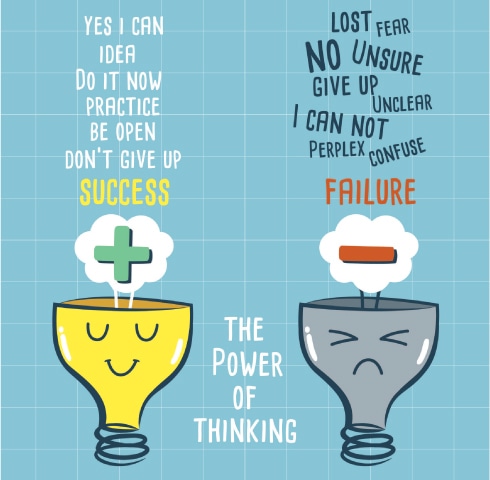

Clearing Your Mind of Negative Thoughts
Imagine if every negative thought arrived with a bright red warning sign that read, “This is just a thought. You don’t have to believe it.” How much easier life would be, right? But unfortunately, that’s not how our minds operate. Negative thoughts rarely announce themselves clearly—they often sneak in under the radar, disguised as valid concerns or legitimate reasoning. And unless we're paying close attention, we tend to accept them as fact, letting them shape our moods, decisions, and view of ourselves.
Our minds, brilliant as they are, can also be master manipulators. Without awareness, we fall for every mental trick, allowing destructive thoughts to spiral into anxiety, self-doubt, or defeat. But the good news is this: you don’t have to be at the mercy of your thoughts. You can take back the reins.
The techniques you’re about to explore give you specific tools for confronting, reframing, and clearing negative mental patterns. Each method stands on its own—some may even seem contradictory—but all are powerful in their own right. Whether used individually or in combination, these strategies offer a practical, empowering path out of mental noise and into clarity.

5 Techniques to Eliminate Negative Thinking
Technique 1: Cut the Thought Immediately
Visualize your mind as a garden. You can cultivate beautiful thoughts with care, or let neglect turn it into a patch of weeds. If you want your inner space to be vibrant and healthy, you’ve got to pull the weeds—fast.
That’s exactly what the “Cut It Off” technique helps you do. The moment you realize you're entertaining a negative thought, stop it in its tracks. Don’t argue with it. Don’t analyze it. Don’t sit with it hoping it passes. Just cut it off. Swiftly.
Once you’ve disrupted the thought, plant a different one in its place—something neutral or positive. The effectiveness of this strategy hinges on your timing. Interrupt the negativity as soon as it appears, and replace it with something that shifts your focus. Over time, your mental habits start to change. It’s like snipping a weed at the root before it spreads across the whole garden.
Technique 2: Give the Thought a Label
This method is as simple as it is effective. As soon as a negative thought enters your awareness, call it out. Label it for what it is. Say to yourself, “Ah, this is just a negative thought. I see it.”
Repeat this reminder if you need to: “It’s just a thought. It’s not reality. I don’t have to believe it.”
Now here’s something worth engraving into your memory:
Negative thoughts only gain power when you react to them.
Yes—read that again. Slowly. A thought, by itself, is powerless. It’s your reaction—worrying, spiraling, overthinking—that breathes life into it. Once you fully grasp this, everything shifts.
So when a negative thought pops in, acknowledge it, label it, and choose not to react. Don’t let it pull you into its drama. Dismiss it like background noise. Move on. The more you practice this, the less control those thoughts will have over you.
Technique 3: Push It Into Absurdity
Sometimes the best way to disarm a negative thought is to take it and run with it… all the way into the realm of the ridiculous.
Let’s say you’re in sales, and your brain whispers, “You’re not going to close another deal today.” Pause. Then exaggerate it:
“That’s right. Not only will I not make a sale, I’ll probably be chased out of the building. Security will sound an alarm. A team of dogs will tackle me on the lawn. Then a banner will unfurl from the windows that reads: ‘You’re a failure!’”
Sound silly? That’s the point.
When you deliberately exaggerate a negative thought into absurd comedy, you rob it of seriousness. Your brain eventually goes, “OK, this is nonsense,” and lets go of the original concern. You may even find yourself laughing. And laughter has a funny way of neutralizing fear.

Technique 4: Replace It with the Direct Opposite
This method uses your mind’s structure to your advantage. You see, your brain can only focus on one thought at a time. So instead of arguing with the negative, you simply crowd it out with its exact opposite.
If the thought says, “I’ll never find love,” replace it with, “A meaningful relationship is coming into my life.”
If it says, “I’m going to fail,” respond with, “I’m on my way to success.”
The goal isn’t blind positivity. It’s active redirection. You are literally switching tracks—moving from a harmful narrative to a supportive one.
Most people unknowingly dwell on what they don’t want. They obsess, worry, visualize failure—and then, without realizing it, attract exactly that. But when you interrupt the process and plant an empowering belief, you take back control.
So next time your mind tries to drag you down a dark alley, flip the script. Speak the opposite out loud if needed. Choose a thought that builds instead of breaks.
Technique 5: Hit It with Repeated Affirmation
Affirmations are like mental conditioning for your mindset. They work especially well on recurring negative thoughts—the ones that pop up like old songs stuck on repeat.
When one of these thoughts surfaces, inform it: “Each time you appear, I’ll hit you with two full minutes of affirmations.” Then do it. Every time. Without fail.
Let’s say the thought is, “I’m not good enough.” Your affirmation becomes:
“I am more than enough. I am capable. I am worthy of success.”
And you repeat that for two minutes straight.
If the negative thought returns later that day, repeat your affirmation again. What you’re doing is training your brain to associate negativity with focused, consistent opposition. Eventually, the negative thought gets tired of showing up—because every time it does, it’s met with strength and clarity.
You’re not just thinking positively. You’re establishing dominance over your internal narrative.
Other Methods to Remove Negative Thoughts From Your Mind
While the previous five techniques provide powerful mental tools to disarm negativity at its root, there are plenty of smaller, daily habits and mindset tweaks that can quietly but profoundly shift your mental state. These strategies might not seem as dramatic as a two-minute affirmation blitz, but they work subtly and steadily, changing how you relate to your inner dialogue over time.
Let’s explore these practical, everyday approaches that can help you steer your thoughts away from the shadows and back toward balance.
1. Shift Your Body Language to Open Up Mentally
Before you even utter a single word, your body tells a story. And when that story is slouched, tense, and closed off, your mind tends to echo the same narrative. Poor posture and a downcast demeanor can reinforce feelings of insecurity, sadness, or frustration—fueling an already negative mental loop.
Take a moment to stand up straight. Roll your shoulders back. Relax your face. Even a gentle smile, real or not, can kickstart a shift in mood. These small physical adjustments tell your brain: “I’m safe. I’m in control.” The more you practice open, confident body language, the more your thoughts will begin to mirror that message.
2. Speak It Out Loud
Bottling up emotion is like placing a lid on boiling water—it builds pressure until it spills over or explodes. Sometimes the best thing you can do when negativity brews inside is to talk.
Whether it’s to a friend, a therapist, or just aloud in an empty room, putting your thoughts into words externalizes them. You can look at them more clearly, question their logic, or discover their roots. The act of verbalizing turns something vague and overwhelming into something concrete you can address.
It doesn’t have to be a formal vent session. Even saying, “I feel off today, and I’m not sure why,” is a form of release. And once it’s out, it’s often easier to move past it.
3. Give Your Mind a Quiet Moment
In the middle of chaos, silence can be revolutionary.
When your brain feels like it’s racing from one anxious thought to the next, intentionally pausing—even for 60 seconds—can reset your mental rhythm. Sit still. Close your eyes. Take one deep breath… and then another. Allow yourself one minute where you aren’t problem-solving, overthinking, or reacting. Just being.
This brief moment of stillness is a chance to pull away from negativity and create space for calm to return. You can build on this moment with meditation or mindfulness exercises if you like—but even a short pause has power.
4. Reframe the Situation
Negativity often thrives not in events themselves but in how we interpret them. The stories we tell ourselves shape our experience.
For example, let’s say you’re facing job difficulties. Instead of thinking, “Everything is going wrong,” try: “I’m being challenged, but I’m learning and adapting.” You’re not denying reality—you’re viewing it through a different lens.
This slight reframing gives you a sense of control and progress. It stops the spiral of despair and encourages productive thinking. Over time, choosing more empowering language rewires your mental patterns.
5. Channel Your Thoughts into Creativity
Negative energy needs an outlet. If you don’t give it one, it tends to take up residence in your thoughts. But if you can channel it—into words, music, sketches, or movement—you gain the upper hand.
Write down what you’re feeling. Doodle your thoughts. Grab an instrument, a paintbrush, or even a keyboard. You don’t need to produce anything polished. What matters is the act of expression. Creativity lets you process emotions, reflect, and sometimes even surprise yourself with insight.
When you give form to what’s been swirling around inside, it stops haunting you in the same way.
6. Take a Walk and Shift Your Scenery
Your environment has more influence than you might realize. If you're surrounded by stress, noise, or negativity—whether it's people, media, or clutter—it can weigh on your mental state like fog.
Stepping away, even for a short walk, can provide a reset. A quiet park, a stroll around the block, or even a visit to a gallery can shift your mental energy. Movement and new surroundings allow your brain to process things differently and can often spark fresh thoughts or emotional clarity.
Nature especially has a calming effect. The physical activity of walking plus the sensory break from your usual space makes this a reliable tool for clearing mental noise.
7. Create a Gratitude Inventory
Negativity can create tunnel vision—it blocks out the good and zooms in on the bad. But the good is almost always still there. You just have to redirect your attention.
Sit down and make a list of what’s right in your life. Big things, small things—it doesn’t matter. Hot coffee on a cold morning, a friend who always texts back, your favorite hoodie, a skill you’ve improved—write it all down.
Practicing gratitude isn’t just feel-good fluff. It trains your brain to seek out positives, even in tough situations. And that shift in focus can weaken the grip of persistent negative thoughts.
8. Acknowledge That Negative Emotions Are Natural
One of the most damaging habits people fall into is judging themselves for feeling low. But here’s the truth: having negative thoughts or feelings doesn’t make you weak—it makes you human.
According to Chicago-based psychotherapist Sarah Farris, emotions—both positive and negative—are essential for connection, reflection, and healing. Suppressing them or feeling ashamed of them only adds a second layer of suffering.
Instead of trying to eliminate all bad feelings, try this: notice them, name them, allow them to exist. Then gently move toward comfort or support. Acceptance makes healing possible.
9. Use Daily Reminders to Lift Yourself Up
Think of your phone as more than just a distraction machine—it can also be your personal hype assistant.
Set reminders throughout the day with short, encouraging messages. Try things like, “You’re doing great,” or “Trust your process,” or even something silly that makes you smile. These micro-boosts disrupt negative thinking and reinforce a more confident, resilient mindset.
You might be surprised how much a few intentional affirmations, sprinkled into your daily routine, can shift your inner dialogue.
10. Reflect on Whether Your Job Is Fueling the Negativity
Sometimes, negative thoughts aren’t just internal—they’re a rational reaction to a draining environment. And one of the most common culprits is work.
Even if you’re performing well, your job may be subtly wearing you down—through impossible expectations, poor leadership, or a toxic atmosphere. As career coach Lori Scherwin notes, persistent anxiety at work can chip away at self-esteem and blur your sense of worth.
If your workplace makes you feel constantly on edge, unheard, or underappreciated, take a closer look. Have an honest conversation with your manager, or consider whether a different job environment would better support your mental health.
11. Smile—Even If You Don’t Feel Like It
This one might sound too simple to matter, but don’t underestimate it. Smiling—yes, even when you’re not in the mood—can genuinely impact your mood and mindset.
Certified coach Sarah J. Cepeda points out that smiling, even if it’s a little forced at first, sends signals to your brain that you're OK. It creates a small opening for joy. Pair your smile with a positive memory, a favorite song, or a moment of appreciation, and you’ll amplify the effect.
It’s not about faking happiness. It’s about using a small physical gesture to invite your mind into a better emotional state.
Negative thoughts are a universal experience. No one is immune. But the more you understand your mind, and the more tools you give yourself, the less power those thoughts hold. And that’s the real shift—from being ruled by them to gently ruling over them.




